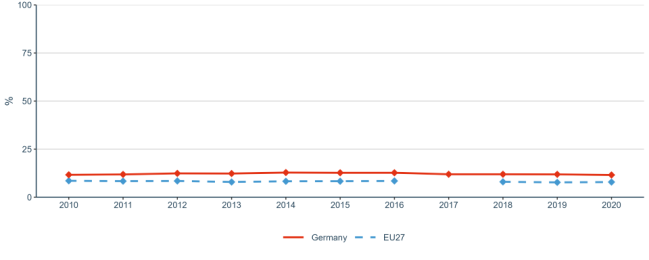ERA Country Report 2023
Germany
Edited by Ieva Savickaite (CARSA)
as part of ‘Development of the ERA Scoreboard, the ERA Dashboard and the Regular Reports’ project for the European Commission, Directorate-General for Research and Innovation under Framework Contract N° 2018/RTD/A2/OP/PP-07001-2018 Lot 2 (EDAR)
Click here to download this country report![]()
- Table of contents
-
ERA Country Report 2023: Germany
1. National context
1.1. Overview of the ERA policy agenda implementation
1.2. Policy context
2. Assessment of the Implementation of the ERA Policy Agenda and ERA Priorities
2.1. ERA Priority 1: Deepening a truly functional internal market for knowledge
2.2. ERA Priority 2: Taking up together the challenges posed by the twin green and digital transition and increasing society’s participation in the ERA
2.3. ERA Priority 3: Amplifying access to research and innovation excellence across the Union
2.4. ERA Priority 4: Advancing concerted research and innovation investments and reforms
3. Country-specific drivers and barriers
4. Final remarks
5. Bibliography
6. Annexes
6.1. Annex 1: Graphs
ERA Country Report 2023: Germany
|
Key takeaways:
|
1. National context
1.1. Overview of the ERA policy agenda implementation
According to the European Innovation Scoreboard 2023, Germany falls into a ´Strong Innovator´ group, as its performance is 117.8% of the EU average. The relative strength of Germany’s performance is due to innovation expenditure per employee. Public-private co-publications and the number of doctorate graduates are also categorised as strengths.^
Germany has committed to all the European Research Area (ERA) Actions and is among the first countries to have a National Action Plan for the European Research Area, which replaces the Strategy from 2014. The National Action Plan, published in November 2023, demonstrates how the Federal Government intends to further advance and fulfil the objectives of the ERA to join forces in close cooperation with European partners.
Other strategic documents at the Federal level include the Pact for Research and Innovation (PFI) of the Federal Ministry of Education and Research (BMBF) and the Excellence Strategy (ExStra) of the German federal and state governments.
1.2. Policy context
The Federal Ministry of Education and Research (BMBF) is the main public actor, holding most of the responsibilities for research and innovation policy at the federal level. It has launched a division dealing specifically with R&I in the EU and has created a special budget as an effective incentive mechanism for funding programmes.^ The budget of the Federal Ministry of Education and Research amounts to around EUR 20,4 billion in 2022 federal budget.^ The Government at federal and state level, including the universities, spent EUR 36,5 billion a year on R&D in 2022, while the private sector spent EUR 81,8 billion a year on R&D (2022).^ Germany invested 3,13% of GDP in R&D in 2022, placing it in the top third of highly developed economies.^ In its coalition agreement, the German government has set a target of investing 3,5% of GDP in R&D by 2025.
The German research and innovation policy is based on the government’s Future Research and Innovation Strategy (Zukunftsstrategie Forschung und Innovation). This strategy creates the framework for an innovation system that contributes to securing Germany's international competitiveness, strengthening society’s resilience and expanding economic strength, ensuring it is in line with ERA priorities and actions.
The National Action Plan for the European Research Area will form the basis for German EU research and innovation policy in the upcoming years. Until 2027, Germany is focussing its ERA efforts on the three guidelines: "For an innovative Europe", "For excellent research in Europe" and "For a free Europe".
Next to the federal level, the German states (“Länder”) are relevant actors concerning the ERA. They are responsible for the higher education system. In addition, they are involved in the research and innovation system, by joining funding at the federal level and own funding.
All questions of research funding, science and research policy strategies and the science system, which jointly affect the federal level and the Länder, are settled in the Joint Science Conference (GWK). Next to the joint regular funding of the main research organisations, many important initiatives are being implemented to strengthen research, education and innovation. One example is the Joint Federal Government-Länder funding programme for junior academics (tenure-track programmes) to enable young scientists to plan a long-term career with the goal of a professorship.
The Pact for Research and Innovation (PFI) is a research-funding initiative of the German Federal and State governments. It is designed to give publicly funded non-university research institutions security through continuous annual budget increases of 3%. The PFI sets out several (rather extensive) research policy goals (currently five) directly tailored by the scientific organisations of the country. The science organisations report on the achievement of these agreements and how they contribute to fulfilling the research policy goals in regular monitoring reports published by the Joint Science Conference (GWK).
2. Assessment of the Implementation of the ERA Policy Agenda and ERA Priorities
Chapter 2 has two objectives: 1) It qualitatively assesses the state-of-play of the implementation of the ERA actions that Germany has committed to. The qualitative information was collected through desk research, specifically analysing reports from the European Semester, the European Innovation Scoreboard, the German ministries’ websites, in particular the Federal Ministry of Education and Research and the OECD STIP survey 2023; 2) It quantitatively assesses the country’s progress towards achieving the ERA priorities as set out on the Pact for Research and Innovation in Europe. The presented quantitative information is mainly based on the ERA Scoreboard and ERA Dashboard indicators and covers longer-term trends since 2010. Additionally, general indicators for the overall R&I system are outlined in Table 1. More detailed information on the data and graphs can be found in Annex 1. This report will serve as a baseline for reporting in the future.
|
Indicator |
Most recent EU average |
Most Recent Metric |
|
Gross Domestic Expenditure on R&D (GERD) as a percentage of GDP |
2.26 (2021) |
3.13 (2021) |
|
Government Budget Allocations for R&D (GBARD) as a share of GDP |
0.76 (2021) |
1.12 (2021) |
|
Researchers (in full-time equivalent) per million inhabitants |
4,483.4 (2021) |
5,538.0 (2021) |
|
Business Enterprise expenditure on R&D (BERD) as a percentage of GDP |
1.49 (2021) |
2.1 (2021) |
Source: compiled by research team based on the ERA Scoreboard and ERA Dashboard indicators
2.1. ERA Priority 1: Deepening a truly functional internal market for knowledge
2.1.1. State of play in the implementation of the ERA Actions
Germany has committed to ERA Action 1: Enable the open sharing of knowledge and the re-use of research outputs, including through the development of the European Open Science Cloud (EOSC). This action is implemented through a number of initiatives with selected examples presented here. In 2016, the BMBF published its Open Access Strategy to foster open access as a standard model for publishing in Germany.^ The National Research Data Infrastructure (Nationale Forschungsdateninfrastruktur, NFDI) was developed in 2019 with the aim of making research data available according to the FAIR principles, and is currently active.^ NFDI involves 26 consortia and one union of consortia from all scientific disciplines working on research data management, services, (meta)standards and trainings to support better access and reuse of research data. The NFDI is Germany’s contribution to the European Open Science Cloud (EOSC). The Research Data Action Plan (Aktionsplan Forschungsdaten) was adopted in 2021 with the aim of strengthening the data culture in science and research by creating data infrastructures, developing new data sources and strengthening researchers’ skills needed to handle digital data.^ Several funding initiatives focus on the improvement of data competencies among researchers, e.g. with a focus on young researchers or research data management at universities of applied science. In addition, 11 Data Competence Centers (Datenkompetenzzentren) have been set up in 2023 to strengthen data-related skills within the higher education and research institutions.
To implement the ERA Action 2: Propose an EU copyright and data legislative framework for research, the Data Strategy of the German Federal Government was adopted in 2021. It foresees the implementation of a number of measures, including putting into place a framework to ensure that more data can be used and shared responsibly and sustainably, while also preventing misuse of data.^ The Research Data Action Plan also includes measures supporting the implementation of this action.
The ERA Action 3: Reform the Assessment System for research, researchers and institutions is implemented through participation in the Coalition for Advancing Research Assessment (CoARA). The 22 German members include national and regional associations, higher education institutions and the German Research Foundation (DFG), which is also represented among the CoARA Steering Board members. The German Research Foundation (DFG) Code of Conduct Guidelines for Safeguarding Good Research Practice calls for a multidimensional approach to assessing the performance of researchers with an emphasis on the quality of a research endeavour. The DFG regards it as a priority to ensure that subject-specific procedures are appropriately represented.
Germany has also committed to ERA Action 4: Promote attractive and sustainable research careers, balanced talent circulation and international, transdisciplinary and inter-sectoral mobility across the ERA. There are a number of strategic documents and funding programmes supporting the implementation of this action. One of the overall aims of the Pact for Research and Innovation (PFI) is to develop attractive working conditions along the entire academic career. The German Research Foundation (DFG) is the self-governing organisation in Germany, which focuses on supporting projects developed within science in the area of knowledge driven research. The DFG pays particular attention to promote international collaboration, researchers in the early career phases and gender equality. The budget of the DFG was around 3.9 billion Euros allocated to fulfil its tasks in 2022.^ The DFG Code of Conduct Guidelines for Safeguarding Good Research Practice also aims to support attractive and sustainable research careers. This action is also supported by funding programmes such as Clusters of Excellence and the Joint Federal Government-Länder funding programme for junior academics (Tenure-Track-Programme). German higher education and research institutions are aware of the principles of the Researchers' Charter (European Charter & Code of Conduct), which, among other things, aims to create better working conditions for researchers and to better establish the research profession. To date, 26 institutions in Germany use the HR Excellence in Research logo and the country continues to promote and involve higher education and research institutions as much as possible in their efforts to obtain the HR Excellence in research logo.
Germany has committed to ERA Action 5: Promote Gender Equality and Foster Inclusiveness, taking Note of the Ljubljana Declaration. Within the framework of the Joint Science Conference (GWK), the Federal and State governments are committed to support gender equality in their jointly funded research institutions and initiatives. They also commit to work on the elimination of gender-based discrimination, containing specific provisions on recruitment procedures, career promotion and Gender Equality Officers. Germany has launched initiatives such as the Programme for Women Professors of the Federal Government and the Laender, Focusing on Innovative Women, Gender aspects in focus, MissionSTEM – Women shape future, German Rectors´ Conference (HRK) Initiative – Diversity at German universities, the Federal Equality Foundation, the Joint Committee of the German Research Foundation (DFG) established ’Research-Oriented Equity and Diversity Standards’.
With the Bonn Declaration, which was adopted during the German EU Council Presidency in 2020, Germany has placed freedom of scientific research on the European Agenda as a common core value and principle for research cooperation within the European Research Area and within international partners. Hence, it is committed to ERA Action 6: Deepening the ERA throughout protecting academic freedom in Europe. EU Member States have not only committed themselves to the protection but also to the promotion of freedom of research. The declaration is a decisive basis for implementation in practice and further development of protection instruments. As a “sponsor” for the ERA Action 6 Germany has a supportive role. Among other things, it facilitates the process set up by the Commission to develop a monitoring for freedom of scientific research in Europe. Germany took also actively part in the Mutual Learning Exercise (MLE) on Foreign Interference, which is a further essential measure of the ERA Action 6.
Germany is strongly committed to ERA Action 7: Upgrade EU guidance for a better knowledge valorisation. Support for this action is incorporated in most of the above-mentioned strategy documents, including the Future Research and Innovation Strategy (Zukunftsstrategie Forschung und Innovation). The Agency for Disruptive Innovations (SPRIND) was set up in 2019 to distribute state funding aimed at accelerating the breakthrough of highly innovative ideas to the market.^ The funding programme “Innovative Hochschule” funded by the German Federal and States governments provides funding for universities of applied sciences as well as small and medium-sized universities to increase knowledge transfer and innovation activities.^ In addition, the German Agency for Transfer and Innovation (DATI) is being set up to facilitate the transfer of scientific knowledge into applications.^
ERA Action 8: Strengthen sustainability, accessibility and resilience of research infrastructures in the ERA, is implemented through participation in the European research infrastructures: Germany was a member of 27 research infrastructures in 2021. This action is also implemented through investments in the National Research Data Infrastructure (NFDI) as mentioned in ERA Action 1. Strengthening research infrastructures is also one of the research policy goals and therefore one of the priorities of the Pact for Research and Innovation (PFI).
To implement Action 9: Promote a positive environment and level playing field for international cooperation based on reciprocity, the Federal government adopted the Strategy on China in 2023. The aim of this strategy is to provide a framework for cooperation with China, increase policy coordination between Germany, EU and China and identify instruments for cooperation.^ International cooperation is also envisaged through the Pact for Research and Innovation (PFI), Open Access Strategy and through the Clusters4Future initiative. Germany has co-organised the first workshop of the Multilateral Dialogue on Values and Principles in International Research Cooperation on academic freedom together with Finland and the Guild in 2022. It has also participated in the working and drafting group for the Team Europe Approach Pilot Africa as well as in the working group for the Team Europe Approach Pilot China as part of the continued EU-Knowledge Network on China (EU-KNOC) initiative.
2.1.2. Progress towards achieving ERA Priorities
With regard to Sub-priority 1.1: Open science, Germany is slightly above the EU average in terms of the share of publications in open access in 2019 (Figure 5 in Annex 1). Measuring progress towards Sub-priority 1.2: Research Infrastructure, the indicator number of European research infrastructures in which a Member State or an Associated Country participated (financially contributes to operations) in 2021 is used. The research infrastructure in Germany is well developed. Participation in European research infrastructures is way above the EU-27 average, with a value of 27 in 2021 compared to an average of 15 in the EU (Figure 6 in Annex 1).
Even though Germany has already launched many initiatives to close the gender gap, according to indicators under Sub-priority 1.3: Gender equality, equal opportunities for all and inclusiveness, compared to the EU-27 average, the proportion of women among doctoral graduates in STEM fields did not increase significantly between 2013 and 2020 (Figure 8 in Annex 1). A slight increase between 2013 and 2020 was seen in the share of women in grade A positions in higher education (Figure 7 in Annex 1). The proportion of women with mixed gender authorship and for proportion of women in authorships of the top 10% most cited publications, 2000–2018 follows similar trend for both the EU-27 and Germany between 2000 and 2020, with the German values slightly lower than the European (Figures 9 and 10 in Annex 1). Moreover, the German value for Women in Digital Index 2021 (Figure 11 in Annex 1) is below the EU-27 average but stills registers almost a 50%.
According to Sub-priority 1.4: Researchers’ careers and mobility and research assessment and reward systems, the available indicator measuring the proportion of foreign doctorate students in 2020 shows that Germany has increased and equalised to above the EU-27 average compared with the data between 2015 and 2020 (Figure 12 in Annex 1). However, according to the indicator measuring new doctorate graduates per 1,000 inhabitants aged 25-34 (Figure 13 in Annex 1) Germany remained below the EU-27 average between 2015 and 2020. Moreover, compared to the EU-27 average, Germany has consistently performed better in respect of job-to-job mobility of Human Resources in Science and Technology (Figure 14 in Annex 1). Noticeable peaks have been reached between 2017 and 2019, with 2019 representing a peak of 10 points compared to an EU-27 average of 5.8 points in job-to-job mobility.
In relation to Sub-priority 1.5: Knowledge valorisation, the share of public-private co-publications per million population shows that Germany has consistently been above the EU-27 average (Figure 15 in Annex 1). The number of PCT patent applications by million GDP between 2010 and 2015 was above the EU-27 average, with a slight decrease between 2012 and 2015 but still remaining above the EU-27 average (Figure 16 in Annex 1). For both indicators measuring businesses enterprise researchers as a % of national researchers and business enterprise researchers in FTE Germany’s is higher than the EU’s by approximately 5 percentages points (Figure 17 in Annex 1). In addition, the business enterprise researchers in FTE per thousand employees in industry (Figure 18 in Annex 1) shows an increasing trend for both areas from 2010 to 2020, with a higher performance of Germany.
Under Sub-priority 1.6: Scientific leadership, Germany ranks the highest in the Academic Freedom Index (AFI) with a consistent ranking of 0.96 between 2010 to 2022 (Figure 21 in Annex 1). Moreover, by a slight margin, Germany has constantly remained above the EU-27 average in terms of the number of scientific publications among the top 10% most cited publications worldwide between 2010 and 2022 (Figure 20 Annex 1).
In relation to Sub-priority 1.7: Global engagement, the share of international co-publications with non-EU partners in the public sector (Figure 22 in Annex 1) shows that Germany has consistently performed above the EU-27 average since 2010. Moreover, the number of international co-publications in Germany increased at a higher rate than that of the EU-27 average. Similar trends are observed regarding European and international co-patenting in EPO applications. Germany consistently performed above the EU-27 average during 2010-2013, when data is available, but the number of applications from Germany fell during this period, narrowing the gap with the EU-27 average (Figure 23 in Annex 1).
2.2. ERA Priority 2: Taking up together the challenges posed by the twin green and digital transition and increasing society’s participation in the ERA
2.2.1. State of play in the implementation of the ERA Actions
Interdisciplinary research projects focusing on developing key technologies and energy efficiency form the basis of the R&I landscape in Germany. The Research for Sustainability Strategy (FONA), the 8th Energy Research programme and the Future Research and Innovation Strategy (Zukunftsstrategie Forschung und Innovation) are the key initiatives for mission-oriented R&I in the country.
To implement ERA Action 10: Make EU R&I missions and partnerships key contributors to the ERA Germany formalised in 2021 a national strategy for the implementation of European Partnerships and established a national platform to involve and exchange information with all relevant stakeholders.^ At national level, the Future Research and Innovation Strategy encompasses six missions which are central to the implementation of the strategy. They include topics reaching from circular economy and sustainable mobility, over climate, food security and biodiversity, health, digital and technological sovereignty and potential of digitalisation, and space and oceans to social resilience, diversity and cohesion.^
Germany has placed a strong focus on R&I to mitigate climate change. Germany has committed to ERA Action 11: An ERA for green energy transformation. As mentioned above, R&I missions are central to the implementation of R&I strategies covering topics related to climate, circular economy and sustainability. The Research for Sustainability Strategy (FONA) adopted in 2021 by the Federal Ministry of Education and Research (BMBF) aims to double the funding for research on climate protection over the next five years to reach EUR 4 billion.^ FONA strategy serves to implement Germany's National Sustainability Strategy and the Federal Government's Future Research and Innovation Strategy, playing a major role in building a sustainable future by achieving the climate goals, researching, and protecting natural resources, and creating knowledge to become faster at translating research findings into practical application.^ Throughout 2021, Germany’s ‘Agenda Process on Green Hydrogen’ organised by BMBF aimed to identify urgent research and innovation questions for Green Hydrogen competitiveness. The National Hydrogen Strategy gained momentum in 2023, with the most recent update focusing on four priority areas: covering the availability of hydrogen, developing hydrogen infrastructure, developing hydrogen applications and the development of favourable conditions.^ In addition to the running 7th Energy Research Programme of the federal government, the 8th Energy Research Programme was launched by the Federal Ministry for Economic Affairs and Climate Action (BMWK) in October 2023. In total, the Federal German Government provides over EUR 500 million per year for the implementation of R&D projects supporting Germany’s energy policy. The key mission-oriented priorities of the programme include transforming the heat and power sector and the ramp-up of the hydrogen economy.^ Lastly, starts-ups are playing a crucial role in energy innovation, for this reason Germany launched a global innovation platform supporting innovation in energy transition called Start Up Energy Transition (SET). The initiative focuses to support, promote and create opportunities for start-ups and to scale-up impact on the global energy transition to reverse climate change.
To commit to ERA Action 12: Accelerate the green/digital transition of Europe´s key industrial ecosystems, Germany has developed cross-sectoral research strategies such as Future Research and Innovation Strategy (2022) German Bioeconomy Strategy (2020) and the National Hydrogen Strategy (2020), alongside the National Skills Strategy (2019) which aim to foster R&I for a green transition in Germany. Germany´s R&I for green transition is aimed mostly on the automotive, aviation and industrial sectors and cross-cutting technologies. The main focus in Germany is on technologies such as robotics, materials and advanced manufacturing, and Artificial Intelligence (AI). For instance, Bavaria’s High-Tech Agenda allocated EUR 600 million for AI, robotics, quantum computing, aerospace and CleanTech. Alternative fuels such as hydrogen as well as Power-to-X technologies are also a priority. The Federal Ministry for Digital and Transport (BMVD) has earmarked EUR 1.4 billion for the Phase 2 (2016-2026) of the National Innovation Programme Hydrogen and Fuel Cell Technology. The digital transition is facilitated by the adoption of the AI Action Plan of the BMBF in 2023 which aims to provide a boost for the German AI landscape and support the implementation of the Federal AI Strategy. Since 2018, the Federal Ministry of Economic Affairs and Climate Action (BMWK) has been funding Regulatory Sandboxes, providing real life environment settings for testing digital innovations and developing the regulatory framework.^
The European Universities Initiative is an initiative which supports European higher education institutions in working together, adding to the diversity of collaboration models in the projects piloted by Erasmus+ and supported through Horizon 2020 and Horizon Europe. More than 50 German higher education institutions participate in such initiatives, supporting Europe´s efforts to achieve the European Education Area by 2025. Germany has committed to ERA Action 13: Empower Higher Education Institutions to develop in line with the ERA, and in synergy with the European Education Area. The overall goal of Action 13 is to enhance the research dimensions at higher education institutions. Next to the regular funding of the Länder the joint Excellence Strategy (ExStra) contributes to this goal as it is a funding programme aimed at strengthening universities by promoting top academic achievements, continuing and developing profiles and collaborations. It provides two main funding streams for Clusters of Excellence and Universities of Excellence.^ The joint programme “Innovative Hochschule” and the National Skills Strategy are contributing to empowering higher education institutions.
Germany committed to ERA Action 14: Bring Science closer to Citizens and aims to strengthen public understanding of scientific research and trust in science through regular citizen outreach and societal participation. In 2013, Germany launched the central platform for citizens in science called Bürger schaffen Wissen (Citizens create knowledge). This platform aims to connect and support citizens science projects as well as to provide an overview of citizens science projects to further increase visibility of citizen science. Germany is also strengthening the development of local, sustainable structures for citizen science with the competition On your marks! – Citizen Science in your town (Auf die Plätze - Citizen Science in deiner Stadt). The competition invites local actors from science, administration and civil society to develop local solutions to local concerns with a citizen science approach. Another project was established in Germany, which also participates in the citizen science initiative, called Plastic Pirates – Go Europe!. The campaign includes school pupils as citizen scientists, providing them with sampling kits to analyse the sources and pathways of plastic pollution. The initiative has now been rolled out at a European scale, supporting the implementation of the Mission Restore our Ocean and Waters. Since 2000, the BMBF has been implementing the Science Years campaign to promote citizen engagement in science and humanities. This is the largest initiative for outreach and public involvement in research in Germany.^ In addition, in 2023, the Strategy for Participation in Research was published, aiming to improve conditions for societal participation in research and research policy.
The Länder commit to the ERA Action 15: Build-up regional and national R&I ecosystems to improve regional/national excellence and competitiveness. Especially the smart specialisation strategies based on ERDF are used to enhance regional ecosystems. Additionally, Saxony has initiated the “White Paper process” as an ongoing dialogue between science, industry and society to create policy principles and guidelines for a research ecosystem of the future.
2.2.2. Progress towards achieving ERA Priorities
In relation to Sub-priority 2.1: Challenge-based ERA actions, the available indicator measuring Germany´s Government Budget Allocations for R&D (GBARD) by NABS in transport, and telecommunications and other infrastructure has consistently remained above the EU-27 average from 2010 to 2021 and experienced a relatively big peak in 2021 (Figure 24 in Annex 1), The GBARD in energy budget allocation constantly increased and reached a maximum between 2018 and 2021. The environmentally related government R&D budget in Germany is slightly above the EU-27 average, with a peak of 1% in 2021, summing the total of 3.2% as a percentage of total government R&D (Figure 26 in Annex 1). According to the OECD patents on environment technologies indicator (Figure 28 in Annex 1) Germany filed more patents on environment technologies than the EU-27 average. Moreover, R&I investments (transnational cooperation): GBARD (EUR) allocated to Europewide transnational, bilateral or multilateral, public R&D programmes per FTE researcher in the public sector^ (Figure 25 in Annex 1) shows a similar trend for Germany and the EU-27 average, with the German values higher than the European average. Similarly, Figure 27 in Annex 1 shows the national public and private investments as suggested in the SET Plan progress report 2021, expressing the gap between Europe and Germany. The German values outperform the EU-27 average noticeably until 2021, while decreasing afterwards.
Germany needs to improve synergies with education and the European Skills Agenda. According to Sub-priority 2.2: Synergies with education and the European Skills Agenda, the available indicator on the share of researchers receiving transferable skills training shows that Germany is below the EU-27 average. The indicator is below the EU-27 average and the percentage decreased in 2019 (38%) compared to the data provided for 2016 (48%) (Figure 29 in Annex 1).
In relation to Sub-priority 2.3: Synergies with sectorial policies and industrial policy, in order to boost innovation ecosystems, Germany performed poorly in comparison with the EU-27 average in terms of direct government support and indirect government support through R&D tax incentives, being consistently around 0.1% between 2013 and 2020 (Figure 30 in Annex 1).
In relation to Sub-priority 2.4: An active citizen and societal engagement in R&I in all its dimensions, Figure 31 in Annex 1 shows that trust in science in 2021 in Germany is slightly below the EU-27 average. Furthermore, the indicator measuring research on social innovation (publications on 'social innovation' or 'social entrepreneurship') shows between years 2011 and 2021 that Germany performed considerably below the EU-27 average. A decrease in the level of research on social innovation was particularly seen in 2018 (Figure 32 in Annex 1). Science communication as well as opportunities for direct and indirect participation have been raised to a new level within the framework of the High-Tech Strategy 2025.
2.3. ERA Priority 3: Amplifying access to research and innovation excellence across the Union
2.3.1. State of play in the implementation of the ERA Actions
Germany has committed to ERA Action 16: Improve EU-wide Access to excellence as a non-widening country, supporting the access to excellence with a wealth of bilateral joint funding programmes called “2+2” projects. Such projects are implemented with Poland or Greek, requiring the participation of at least one German and one non-German research institution and at least one German and one non-German company to strengthen initiatives in the field of applied research and technology transfer. It enables to exploit synergies and complementarities between the two countries science and industry. The BMBF also provides funding for research and development projects in the framework of EUREKA with partners in Hungary, Czech Republic, Croatia, Slovakia, Albania and Montenegro. The aim is to access research which can be transferred into applications in areas such as artificial intelligence, quantum technology, autonomous machines/autonomous systems, industry 4.0 or biotechnology.^
Moreover, Germany has been committed to ERA Priority ERA Action 17: Enhance the strategic capacity of Europe´s public research performing organisations since 2016 by initiating the ERA Fellowships Science Management Programme. Germany is one of the sponsors of Action 17 and continues its commitment to the Action’s goals. It is represented in the Action 17 core group both as a member state and with a stakeholder expert for research management trainings. Two leading German stakeholder organisations are present in the EU project RM roadmap’s ambassador’s initiative.
2.3.2. Progress towards achieving ERA Priorities
In relation to Sub-priority 3.1: More investments and reforms in countries and regions with lower R&I performance, the available indicator measures the increase (in percentage points) of total R&D expenditure expressed as a percentage of GDP. As seen in Figure 33 in the Annex, both the German and the EU-27 trends fluctuate during the period. Still, the country´s has mainly performed above the European values over the period, except for 2013 and 2020 when Germany registered lower data.
2.4. ERA Priority 4: Advancing concerted research and innovation investments and reforms
2.4.1. State of play in the implementation of the ERA Actions
Germany is committed to ERA Action 19: Establish an efficient and effective ERA monitoring mechanism. Germany actively participates in the ERA Monitoring Mechanism (EMM), leading the development of ERA progress reports and providing relative data to monitor different indicators.^ Thus, Germany has an evaluation and monitoring system in place and has updated its national R&I documents and reformed R&I bodies based on the results. Germany´s Future Research and Innovation Strategy and its precursor strategy, the High-Tech Strategy 2025 are seen as successful models for adaptive research and innovation strategies.^ In September 2019 Germany launched a new foresight process entitled “VORAUS:schau!”, which since 2022 has been re-focussed on the monitoring and identification of (potential) critical and emerging technologies. It is complemented by INSIGHT, the impact assessment of technological and social innovations. The Future Research and Innovation Strategy (BMBF) puts emphasis on clear indicators and performance measurement. The National Action Plan for the European Research Area explicitly takes up several core indicators to monitor success of German ERA policy.
2.4.2. Progress towards achieving ERA Priorities
In general, it can be observed that the government budget allocation for R&D is higher than in other EU countries. In relation to Sub-priority 4.1: Coordination of R&I investments Germany consistently had a share of between 11% and 13% of public R&D expenditures financed by the private sector, which is above the EU average of (8%-9%) (Figure 34 in Annex 1).
3. Country-specific drivers and barriers
Overall, the country is well positioned in most of the fields of the ERA due to the high political significance allocated to R&I. Progress towards establishing better cooperation between the Federal Ministries was made in 2021 by creating the Federal Government´s Future Research and Innovation Strategy (Zukunftsstrategie Forschung und Innovation). This strategy has promoted inter-ministerial cooperation within mission-oriented R&I policy, accelerating the transition of ideas from research into practice. Similarly, the development of the Start-Up Strategy has improved the regulatory framework on the financing of spin-offs, especially related to scientific-based ideas^. Additionally, the country has succeeded in the process towards digitalisation especially in AI. The Federal Government’s Artificial Intelligence Strategy was approved and complemented in 2023 by an AI Action Plan of the Federal Ministry of Education and Research. This programme aims to make Germany a front-runner in AI research, development and application, and expand the AI ecosystems in Germany and Europe to strengthen the application of AI on a broad scale.
The circular economy has been demonstrated to be an opportunity for German development and growth. As expressed by the European Semester Report of 2023^, the country will benefit from increasing efforts towards the green transition. In this sense, the country is involved with the European Social Fund (ESF+) to strengthen research towards sustainability, among other reasons. Moreover, a Strategic Research and Innovation Agenda (SRIA) on green hydrogen, coordinated by the German Federal Ministry of Education and Research (BMBF), is a transnational initiative in the ERA involving science, industry, and civil society to accelerate the upscaling of the hydrogen economy.
Germany has already launched many initiatives to address the areas where more challenges have been found when implementing the ERA. For example, the reduced funding in intangible assets in areas related to R&I implies a certain obstacle for making faster progress in achieving the ERA priorities.^ In addition, even though German public and private organisations have adopted initiatives aiming to reduce gender gap and promote women in research, women continue to be significantly underrepresented in research and development in Germany.
4. Final remarks
Germany is a Strong Innovator, and the government spending in R&I is above the EU-27 average. Germany has demonstrated its commitment to all ERA Actions and is among the countries setting up a national vehicle for the ERA, the National Action Plan for the European Research Area. Germany has launched several initiatives and strategies at the national level to achieve all ERA priorities fully. Efforts have concentrated on actions to deepen a truly functioning internal market for knowledge and areas on green transitions and digital transformation. R&I is focused on cross-cutting technologies such as robotics, materials and advanced manufacturing, artificial intelligence, and green hydrogen economy.
Germany is above the EU average in priority areas such as open science (1.1), research infrastructures (1.2), knowledge valorisation (1.5), scientific leadership (1.6) and global engagement (1.7). Sub-priority 1.3 gender equality and inclusiveness have been seen as the only area under Priority 1 that continues to be challenging. Most sub-priorities under Priority 2 have experienced stagnation or decreasing trends during the past years. Germany performed above the EU-27 average coordination R&I investments (4.1) under Priority 4. Germany may improve in ERA sub-priorities such as synergies with education and the European Skills Agenda (2.2) and synergies with sectoral policies and industrial policy, to boost innovation ecosystems (2.3), where indicators illustrate that the country's development remains below the EU-27 average.
5. Bibliography
A stronger partnership in the European Research Area in the name of excellence and growth (2012). European Commission. https://eur-lex.europa.eu/legal-content/DE/TXT/PDF/?uri=CELEX:52012DC0392&from=en
Action Plan Research Data (2021). https://www.bmbf.de/bmbf/de/forschung/digitale-wirtschaft-und-gesellschaft/aktionsplan-forschungsdaten/aktionsplan-forschungsdaten_node.html
Agency for Disruptive Innovations (SPRIND). (n.d.). OECD STIP Website. https://stip.oecd.org/stip/interactive-dashboards/policy-initiatives/2023%2Fdata%2FpolicyInitiatives%2F99993139
Artificial Intelligence Strategy (2020). Federal Government. https://www.ki-strategie-deutschland.de/home.html
CoARA Coalition (n.d.) CoARA. https://coara.eu/coalition/membership/
Country Report Germany (2022). ERA Learn. https://www.era-learn.eu/documents/country_report_germany
Data Competence Centres. https://www.bildung-forschung.digital/digitalezukunft/de/wissen/Datenkompetenzen/datenkompetenzzentren_f%C3%BCr_die_wissenschaft_ordner/datenkompetenzzentren_fuer_die_wissenschaft_node.htmlData Strategy of the German Federal Government. (n.d.). OECD STIP Website. https://stip.oecd.org/stip/interactive-dashboards/policy-initiatives/2023%2Fdata%2FpolicyInitiatives%2F4600
Data Strategy of the German Federal Government. OECD STIP Website. https://stip.oecd.org/stip/interactive-dashboards/policy-initiatives/2023%2Fdata%2FpolicyInitiatives%2F99996261
DATI: German Agency for Transfer and Innovation (2023). BMBF. https://www.bmbf.de/bmbf/de/forschung/dati/deutsche-agentur-fuer-transfer-und-innovation_node.
DFG (2019) Code of Conduct Guidelines for Safeguarding Good Research Practice. https://www.dfg.de/download/pdf/foerderung/rechtliche_rahmenbedingungen/gute_wissenschaftliche_praxis/kodex_gwp_en.pdf
Directorate-General for Research and Innovation. https://op.europa.eu/en/publication-detail/-/publication/98a8edb4-c763-11ec-b6f4-01aa75ed71a1/language-en/format-PDF/source-256243590
Energy Programme from BMBF. The Federal Ministry for Economic Affairs and Climate Action.https://www.energieforschung.de/energieforschungsprogramm/energieforschungsprogramm-des-bmwk
ERA Learn, Country Report Germany, available at: https://www.era-learn.eu/documents/country_report_germany
Eureka. (n.d.). OECD STIP. https://stip.oecd.org/stip/interactive-dashboards/policy-initiatives/2023%2Fdata%2FpolicyInitiatives%2F99996495
European Commission, European Innovation Scoreboard 2023. https://ec.europa.eu/assets/rtd/eis/2023/ec_rtd_eis-country-profile-de.pdf
European Commission, Study to evaluate the ERA policy framework and ERA monitoring mechanism, 2021. Directorate-General for Research and Innovation. Available at: https://op.europa.eu/en/publication-detail/-/publication/98a8edb4-c763-11ec-b6f4-01aa75ed71a1/language-en/format-PDF/source-256243590
Excellence Strategy. German Research Foundation (DFG). https://www.dfg.de/en/research_funding/funding_initiative/excellence_strategy/
Federal Government Report on the High-Tech Strategy (2025). Federal Government. https://www.bmbf.de/SharedDocs/Publikationen/de/bmbf/FS/657232_Bericht_zur_Hightech-Strategie_2025_en.pdf?__blob=publicationFile&v=2
Federal Ministry of Education and Research (BMBF), Pact for Research and Innovation/ Pakt für Forschung und Innovation. https://www.bmbf.de/bmbf/de/forschung/das-wissenschaftssystem/pakt-fuer-forschung-und-innovation/pakt-fuer-forschung-und-innovation_node.html
Future Research and Innovation Strategy (2023). BMBF. https://www.bmbf.de/bmbf/en/research/future-research-and-innovation-strategy/future-research-and-innovation-strategy_node.htm
German Research Foundation (n.d). https://www.dfg.de/de/dfg-profil/ueber-die-dfg/was-ist-die-dfg
GWK (2005), Pact for Research and Innovation. https://www.gwk-bonn.de/themen/foerderung-von-ausseruniversitaeren-wissenschaftseinrichtungen/pakt-fuer-forschung-und-innovation
Innovative Hochschule. (n.d.). OECD STIP Website. https://stip.oecd.org/stip/interactive-dashboards/policy-initiatives/2023%2Fdata%2FpolicyInitiatives%2F16443
National Hydrogen Strategy. The Federal Ministry of Education and Research. https://www.bmbf.de/bmbf/de/forschung/energiewende-und-nachhaltiges-wirtschaften/nationale-wasserstoffstrategie/nationale-wasserstoffstrategie.html
National Research Data Infrastructure. NFDI: https://www.nfdi.de
National strategy for the implementation of European Partnerships. (n.d.) OECD STIP. https://stip.oecd.org/stip/interactive-dashboards/policy-initiatives/2023%2Fdata%2FpolicyInitiatives%2F99992189
Recommendation for a Council Recommendation on the 2023 National Reform Programme of Germany and delivering a Council opinion on the 2023 Stability Programme of Germany (2023). European Commission. https://economy-finance.ec.europa.eu/system/files/2023-05/DE_SWD_2023_6…
Regulatory Sandboxes. OECD STIP compass website: https://stip.oecd.org/stip/interactive-dashboards/policy-initiatives/2023%2Fdata%2FpolicyInitiatives%2F25893
Research for Sustainability (2021). BMBF. https://www.bmbf.de/SharedDocs/Publikationen/de/bmbf/FS/31648_Forschung_fuer_Nachhaltigkeit_en.pdf?__blob=publicationFile&v=6
Research for sustainable development. (2023) BMBF. https://www.fona.de/en/about-fona/research-for-sustainable-development.php
Science Years. (n.d.) OECD STIP. https://stip.oecd.org/stip/interactive-dashboards/policy-initiatives/2023%2Fdata%2FpolicyInitiatives%2F3148
Strategic Research and Innovation Agenda Process for the European Research and Innovation Initiative on Green Hydrogen (n.d.). Federal Ministry of Education and Research (BMBF).https://www.bmbf.de/bmbf/shareddocs/downloads/files/SRIA_green_hydrogen.pdf?__blob=publicationFile&v=4
Strategic Research and Innovation Agenda Process for the European Research and Innovation Initiative on Green Hydrogen. Federal Ministry of Education and Research (BMBF). https://www.bmbf.de/bmbf/shareddocs/downloads/files/SRIA_green_hydrogen.pdf?__blob=publicationFile&v=4
Strategy of the Federal Government on the European Research Area (ERA) (n.d.). Federal Ministry of Education and Research (BMBF).https://www.bmbf.de/SharedDocs/Publikationen/de/bmbf/FS/23902_Strategie_der_Bundesregierung_zum_EFR_en.pdf?__blob=publicationFile&v=3
Strategy of the Federal Government on the European Research Area (ERA). Federal Ministry of Education and Research (BMBF).
Strategy on China. (2023) Federal Government. https://www.auswaertiges-amt.de/blob/2608578/810fdade376b1467f20bdb697b2acd58/china-strategie-data.pdf
The ESF in Germany (2022). ESF+. https://european-social-fund-plus.ec.europa.eu/en/support-your-country/esf-germany-0#:~:text=The%20EU%20will%20invest%20EUR,background%2C%20into%20the%20labour%20market.
The Federal Government, Federal Government Report on the High-Tech Strategy 2025. BMBF.https://www.bmbf.de/SharedDocs/Publikationen/de/bmbf/FS/657232_Bericht_zur_Hightech-Strategie_2025_en.pdf?__blob=publicationFile&v=2
Women in research and development: Germany lags behind the rest of the EU (2023) German Federal Statistical. https://www.destatis.de/Europa/EN/Topic/Science-technology-digital-society/FemaleResearchers.html#:~:text=Women%20continue%20to%20be%20significantly,%25)%20and%20Luxembourg%20(27%25).
6. Annexes
6.1. Annex 1: Graphs
The 2023 ERA Scoreboard and ERA Dashboard indicators used in the country report are presented in this annex. Detailed information on the data sources, description of the indicators, time period for which the data is available, and the necessary calculations can be found in the ERA Scoreboard and ERA Dashboard Methodology Report. The most recent available data for each indicator has been used.
General Indicators


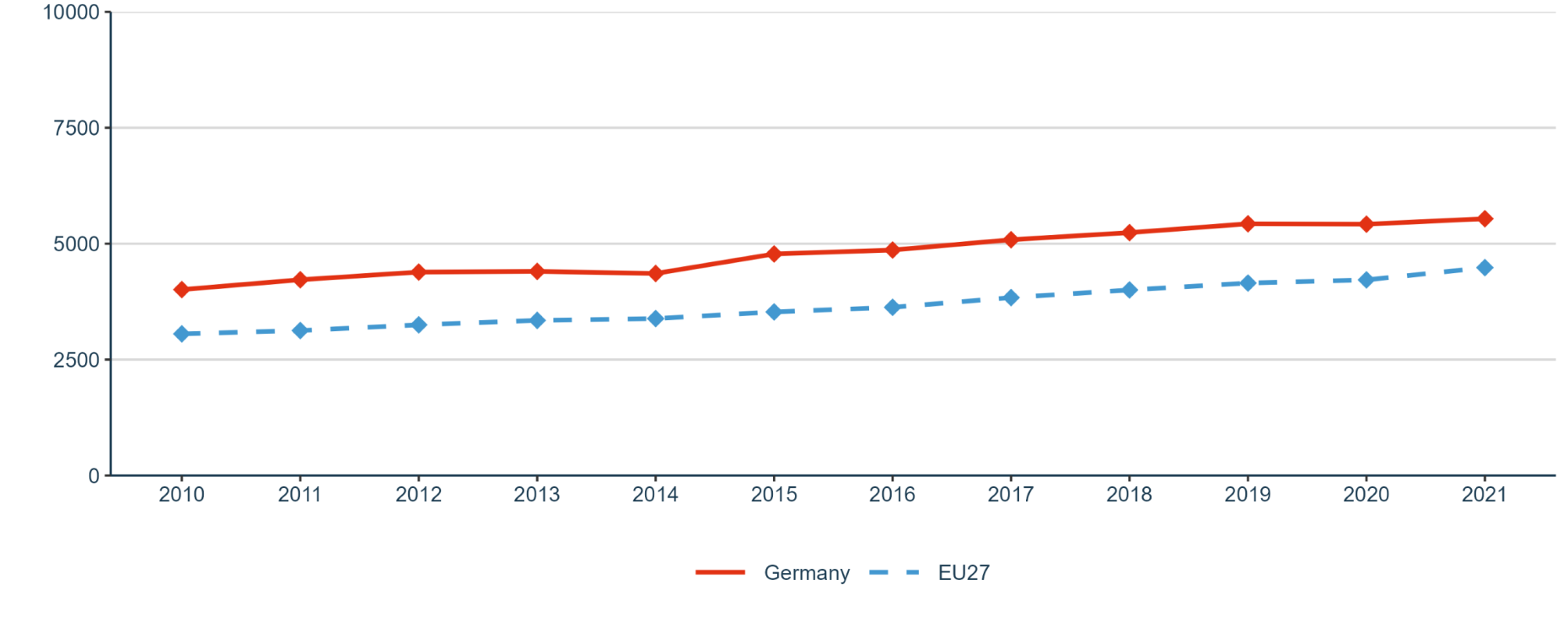
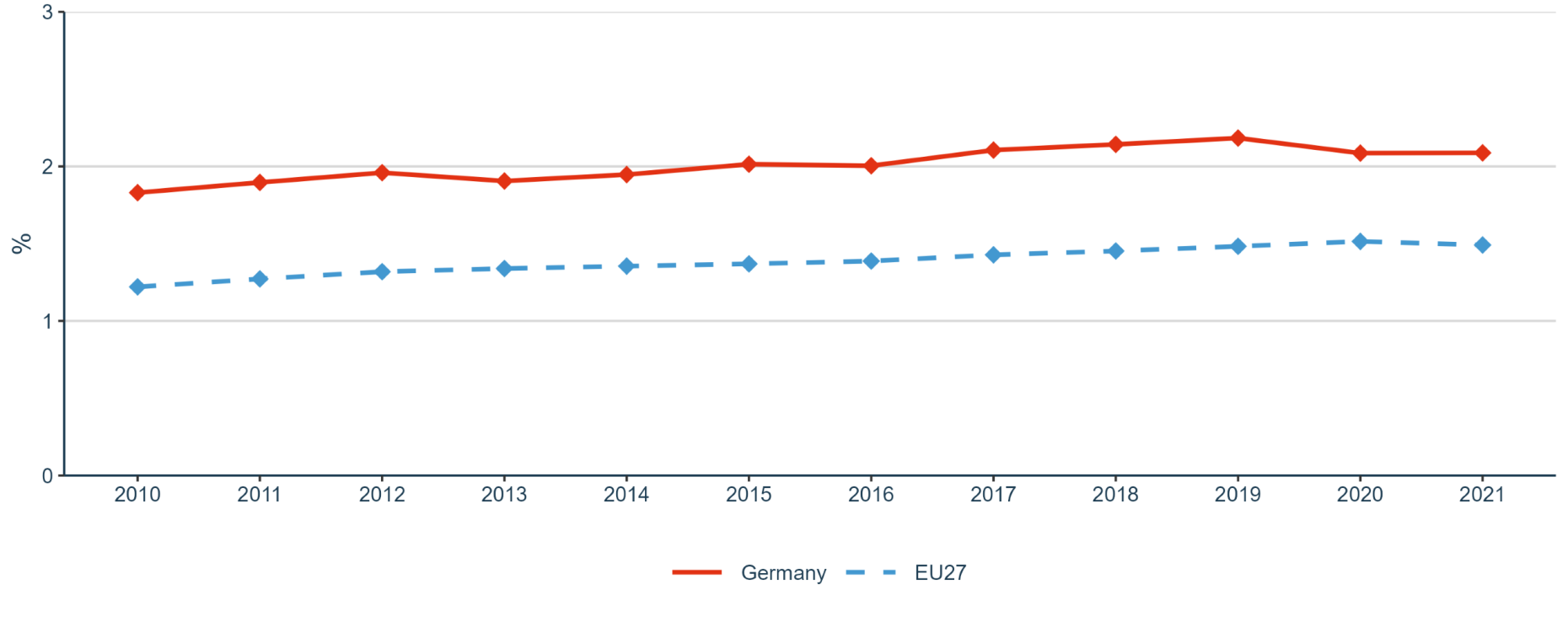
Priority 1: Deepening a truly functioning internal market for knowledge
Sub-priority 1.1: Open Science

Sub-priority 1.2: Research infrastructures
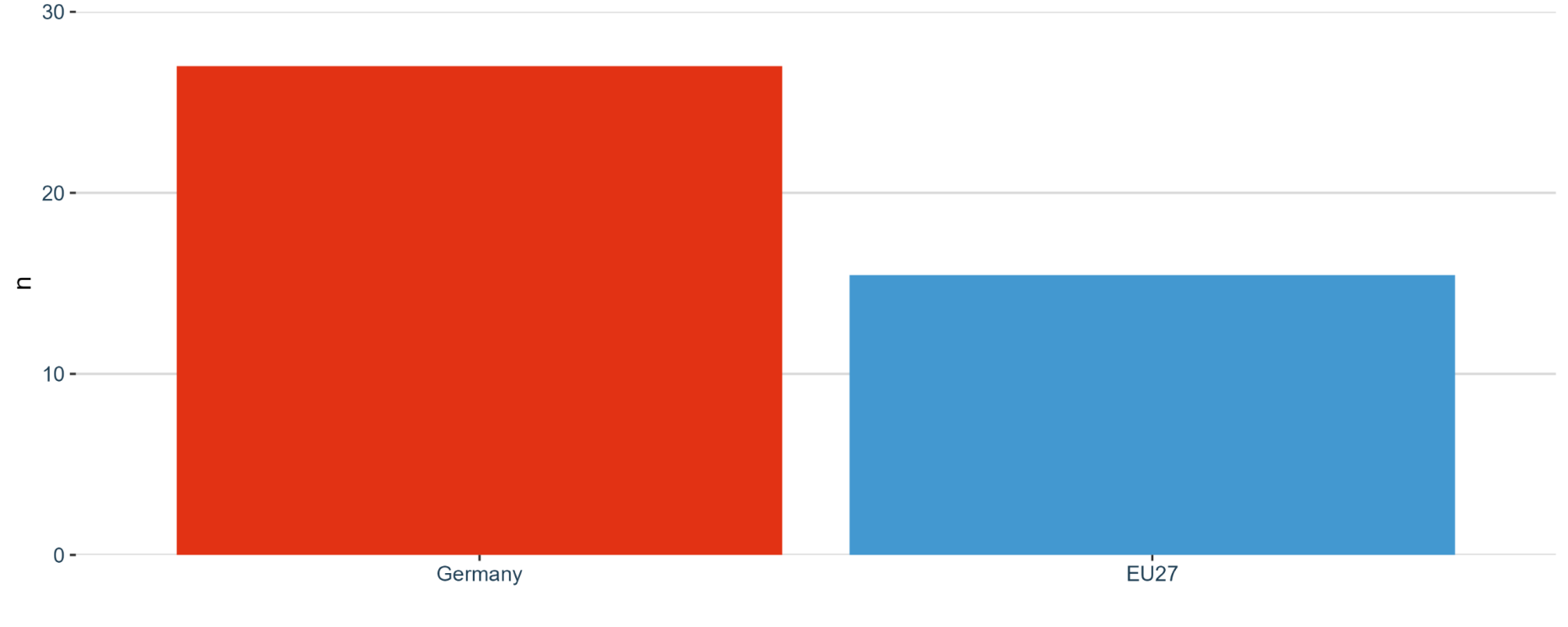
Sub-priority 1.3: Gender equality, equal opportunities for all and inclusiveness
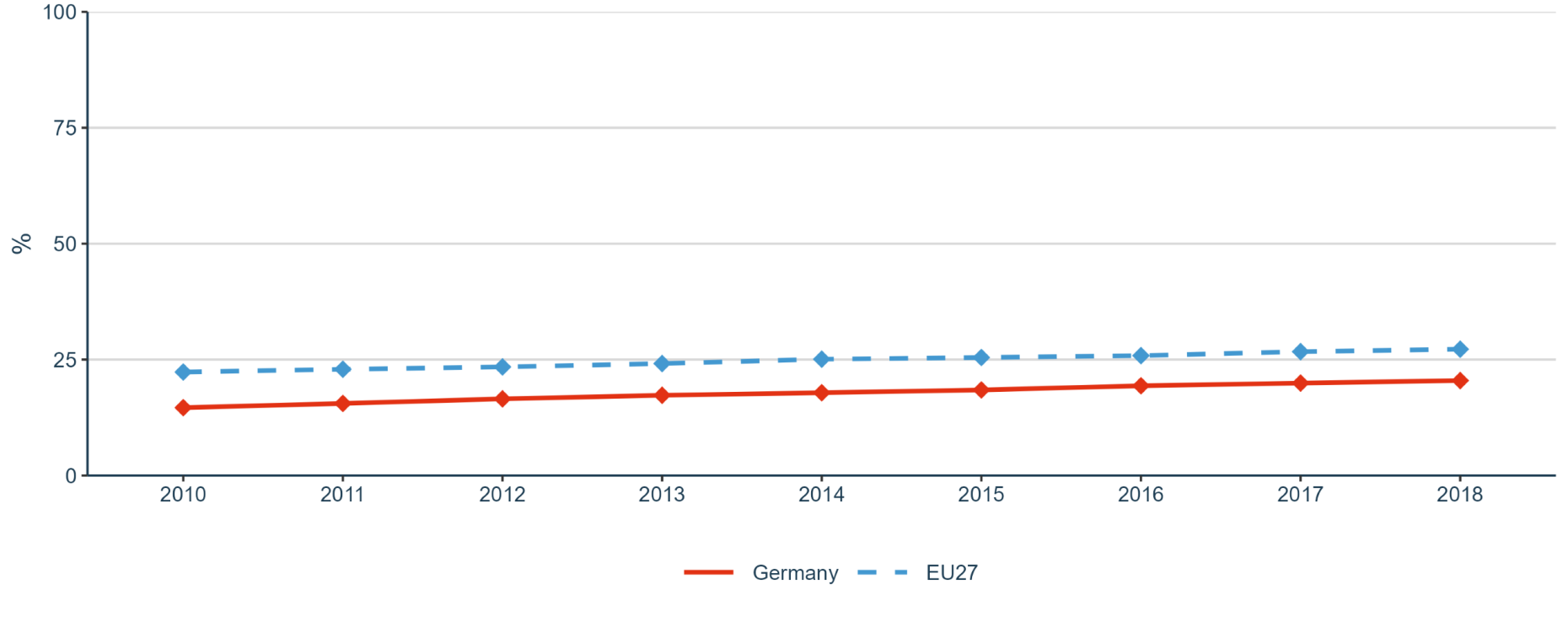
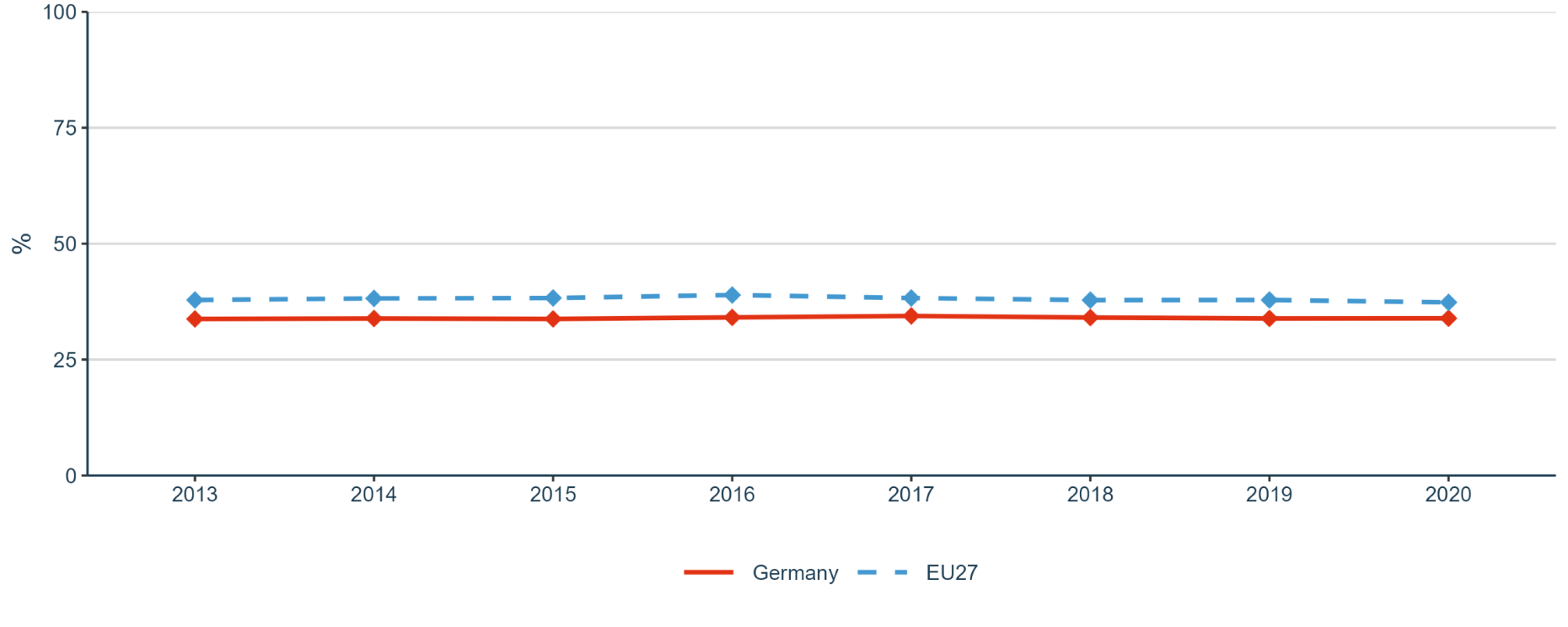
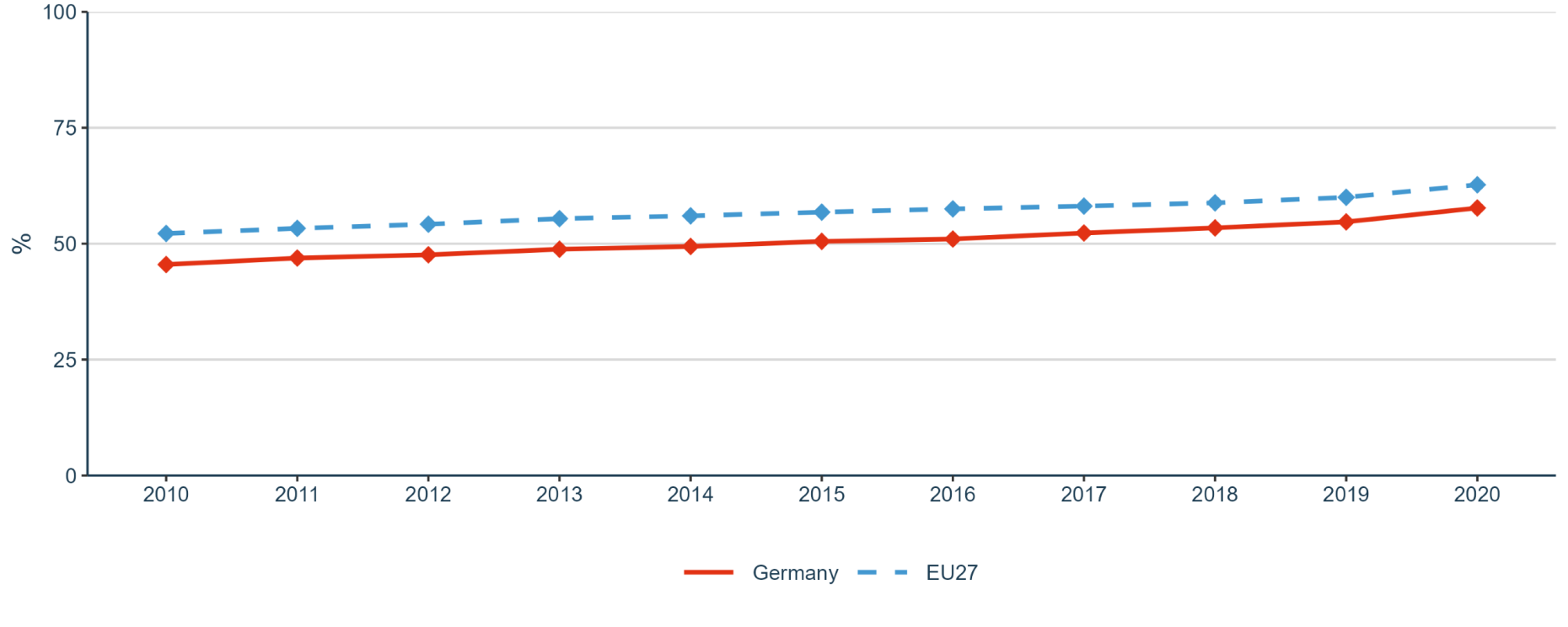
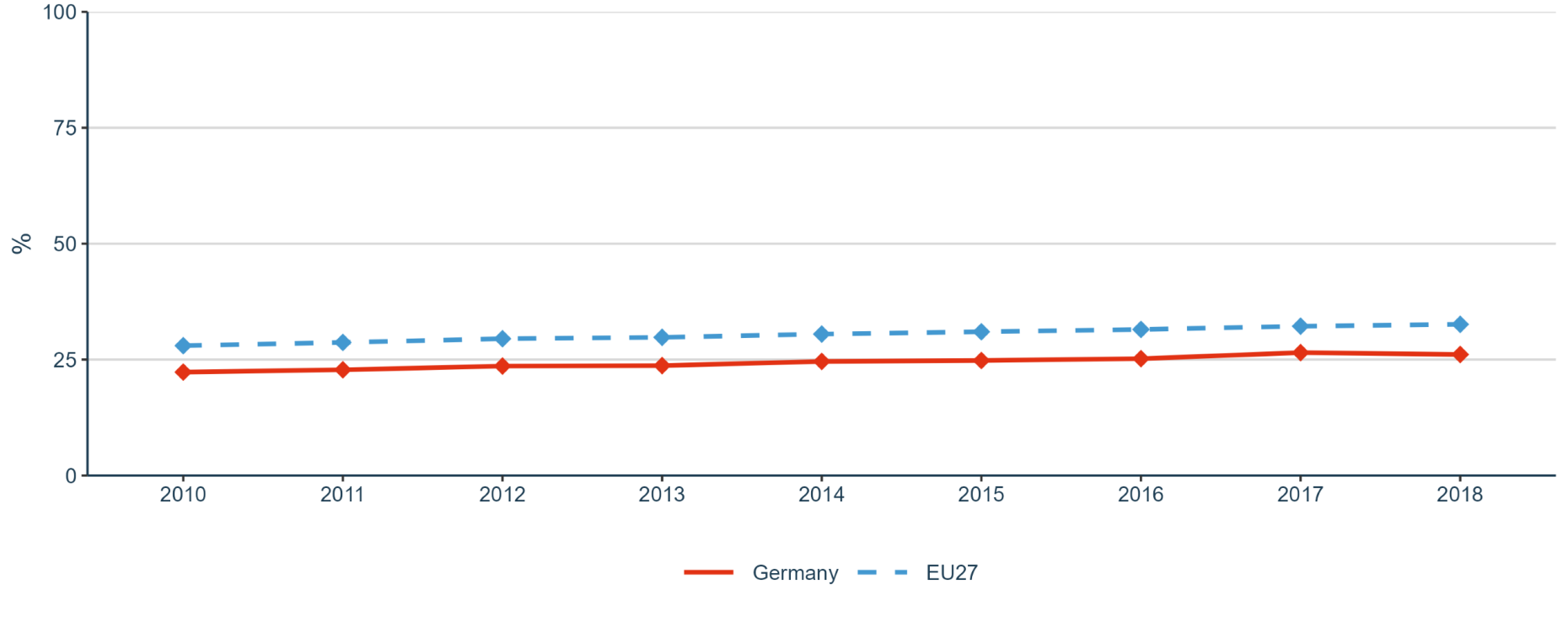
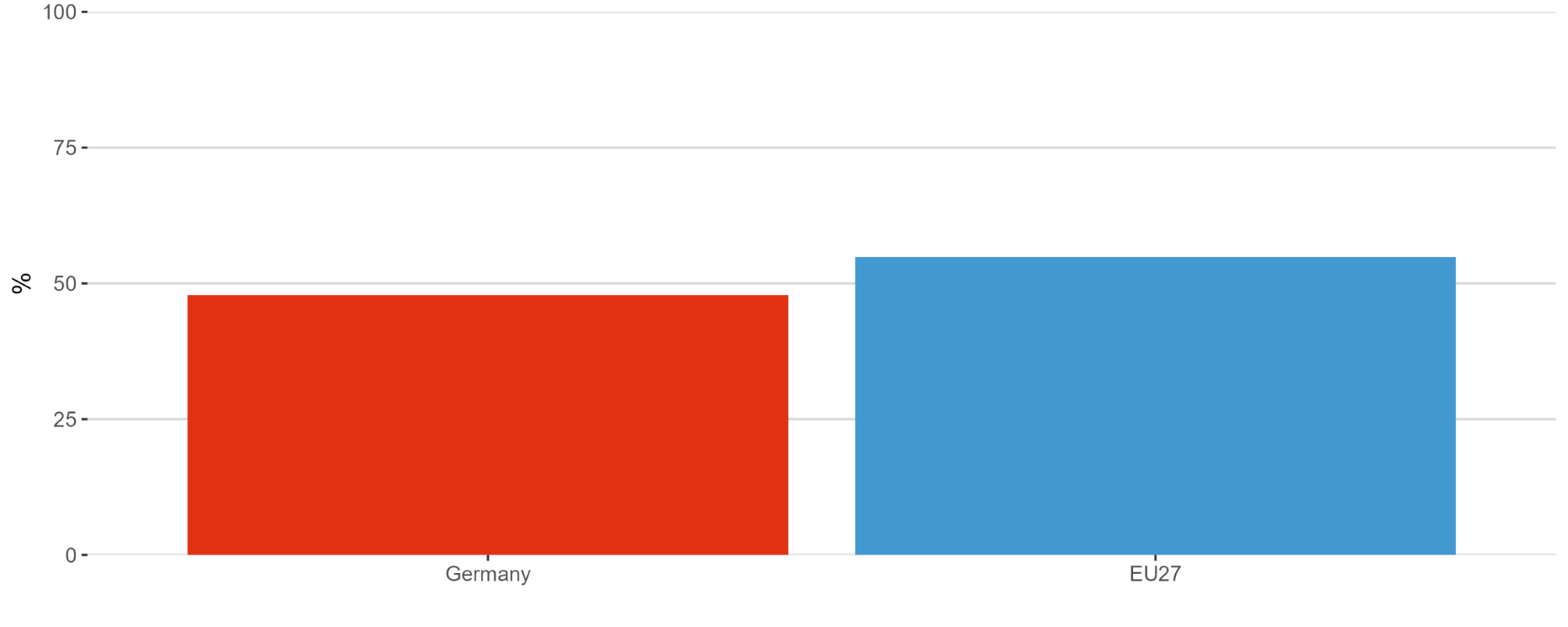
Sub-priority 1.4: Researchers’ careers and mobility and research assessment and reward systems

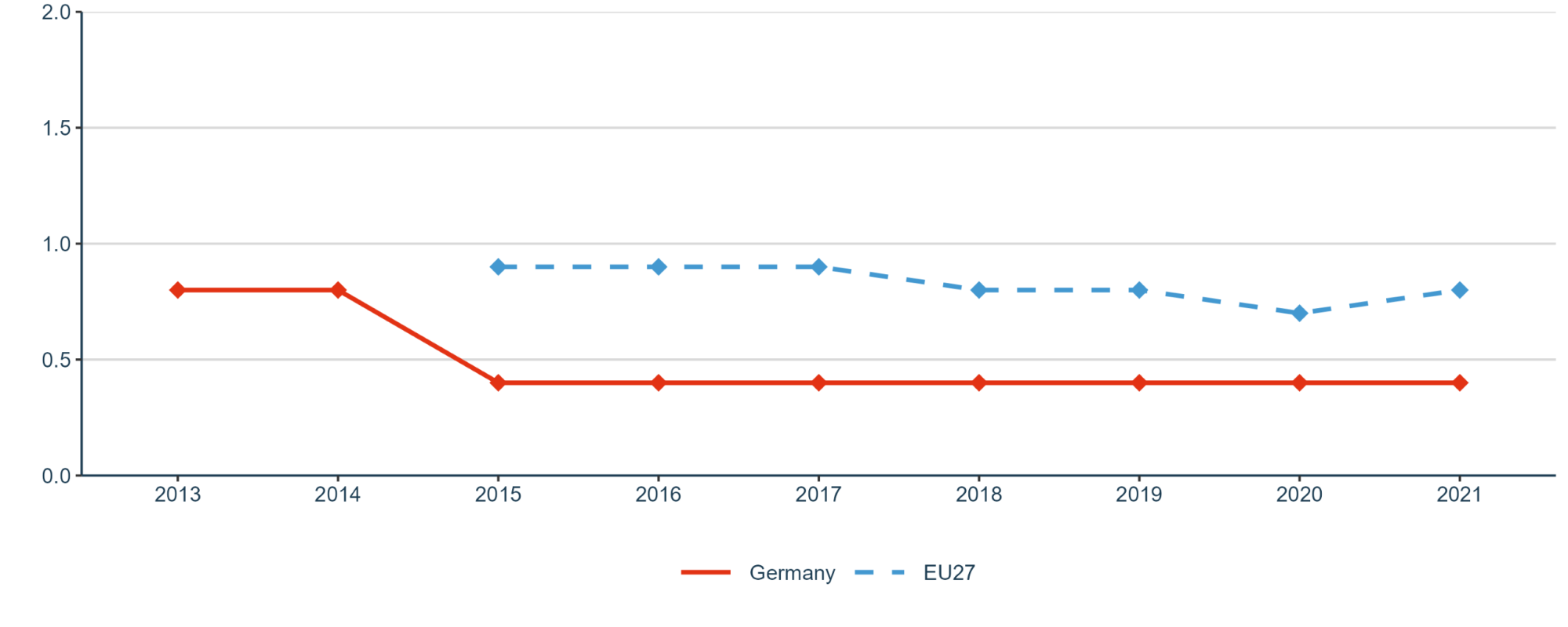
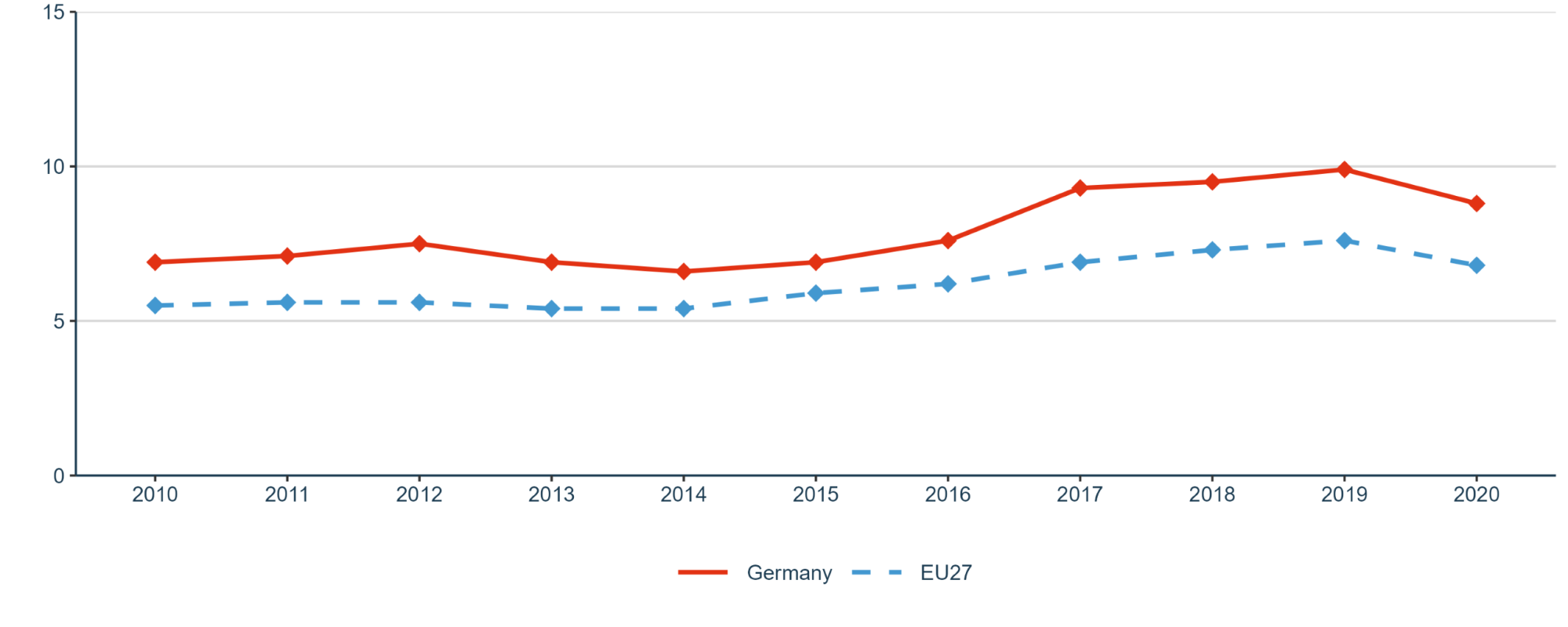
Sub-priority 1.5: Knowledge valorisation

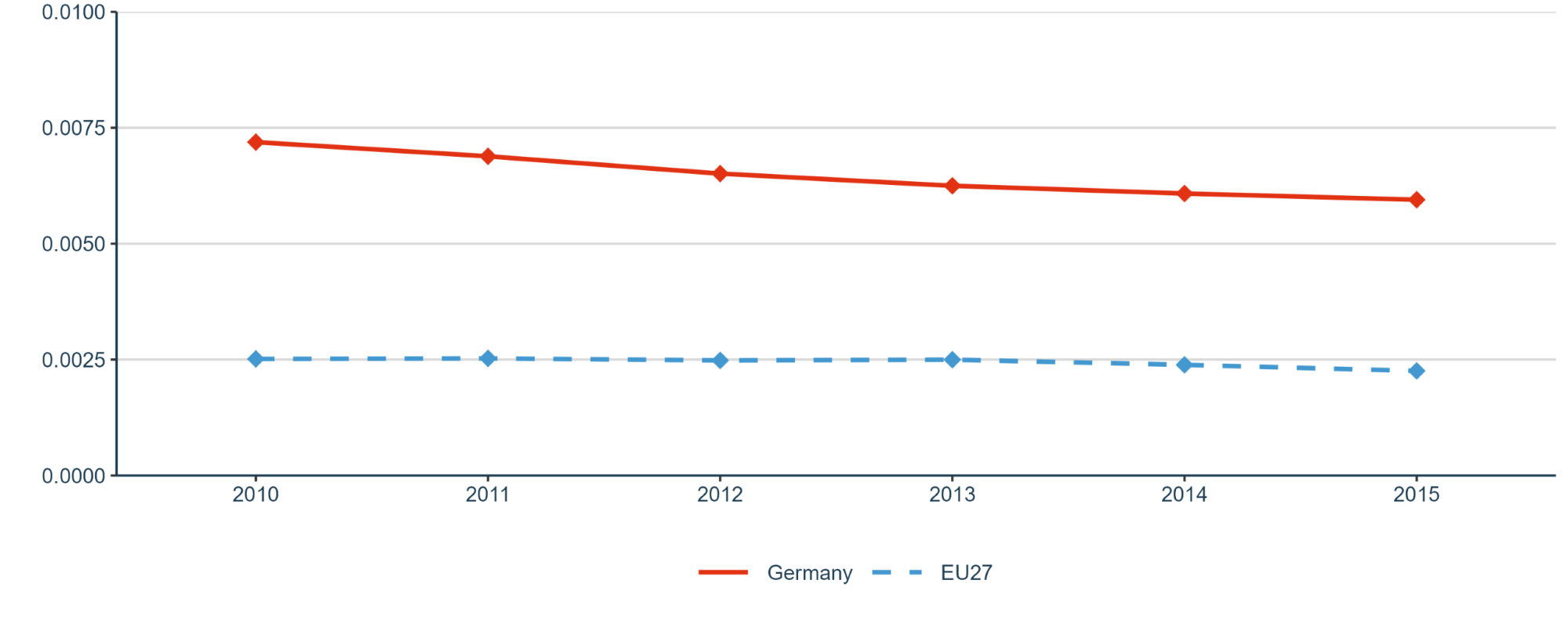
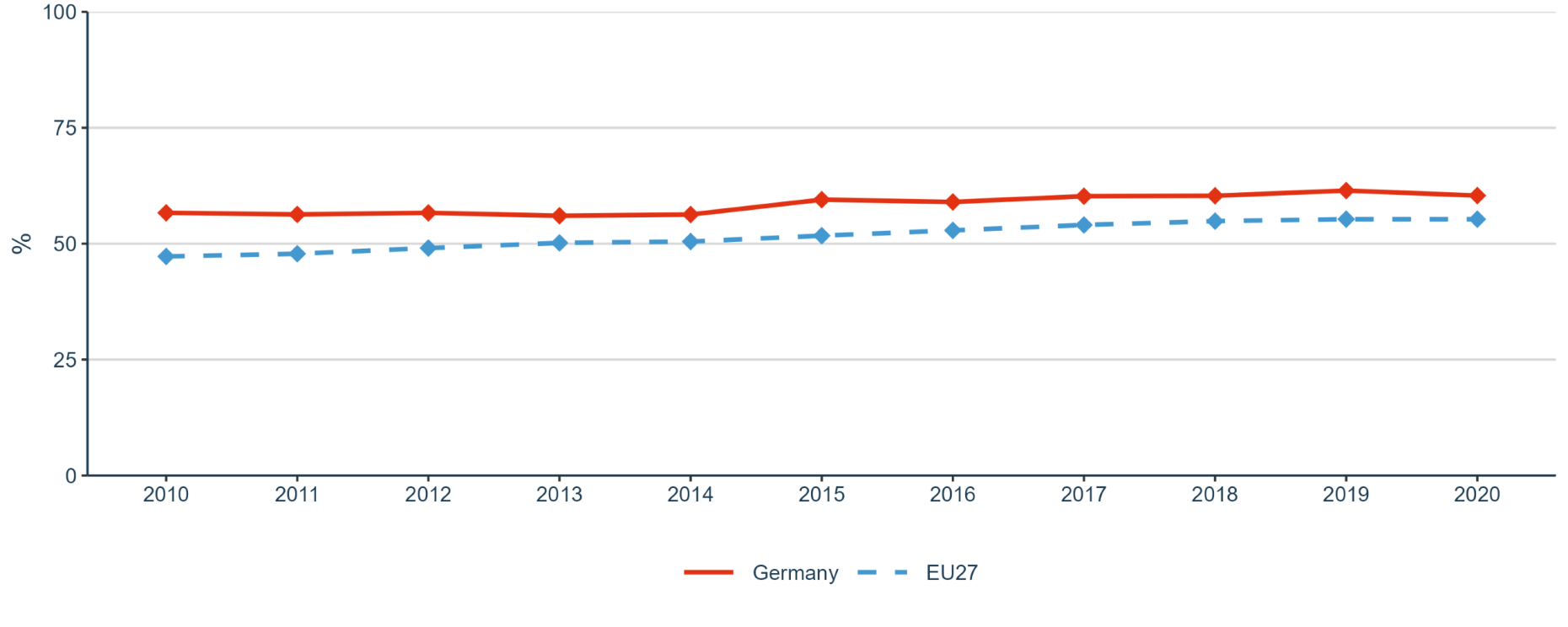

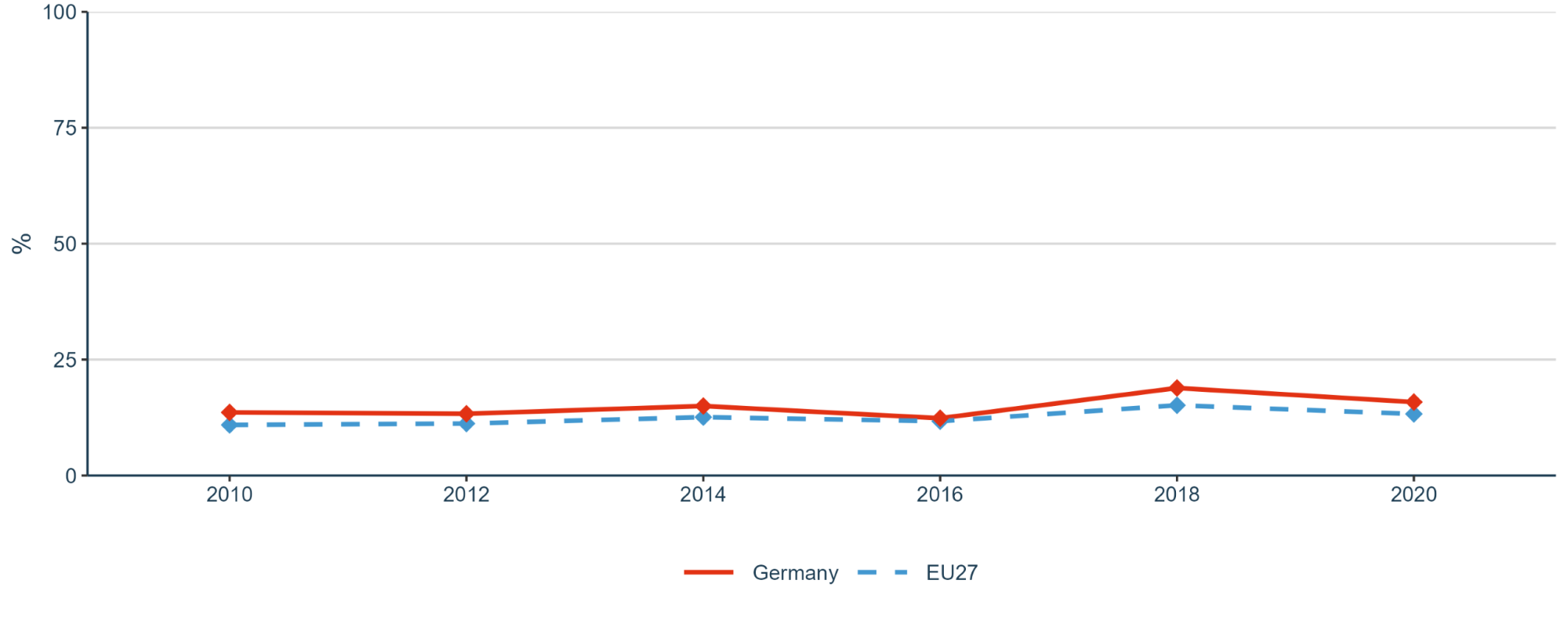
Sub-priority 1.6: Scientific leadership
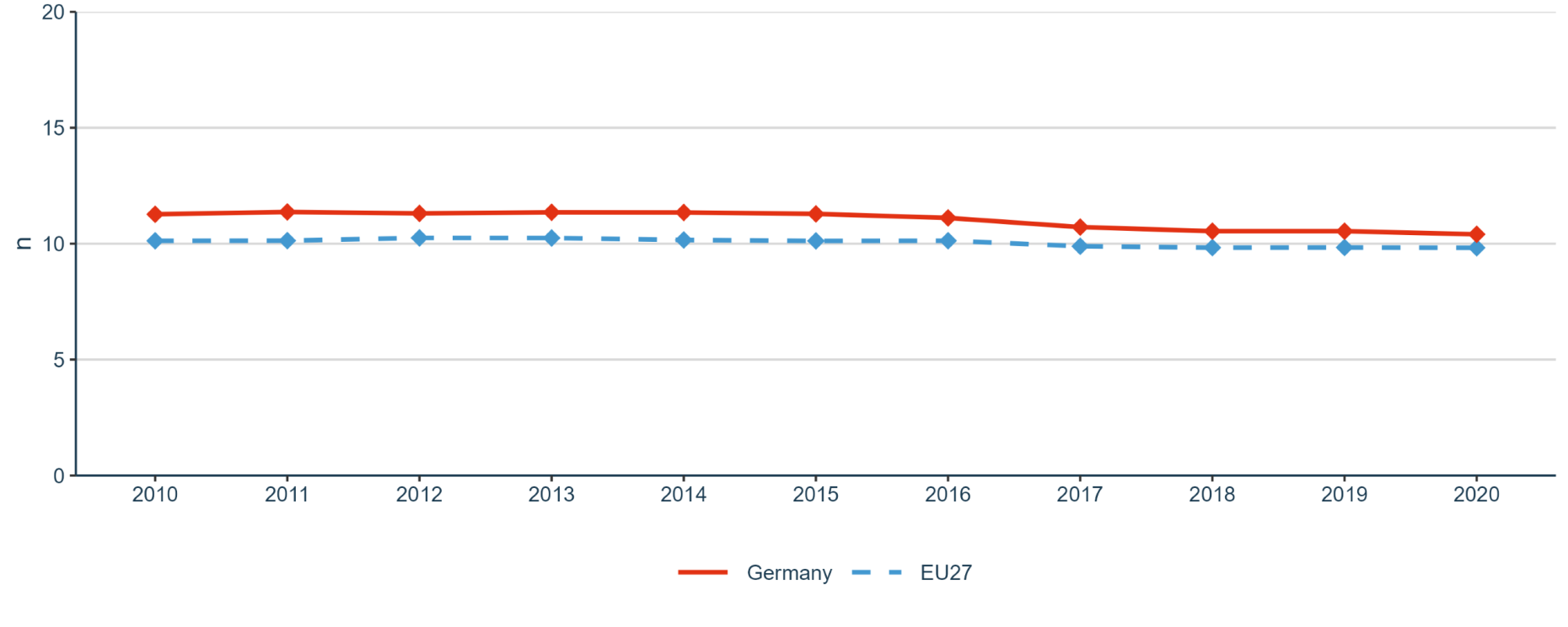

Sub-priority 1.7: Global engagement

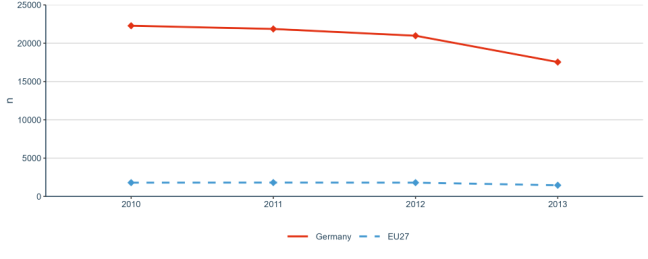
Priority 2: Taking up together the challenges posed by the twin green and digital transition, and increasing society’s participation in the ERA
Sub-priority 2.1: Challenge-based ERA actions
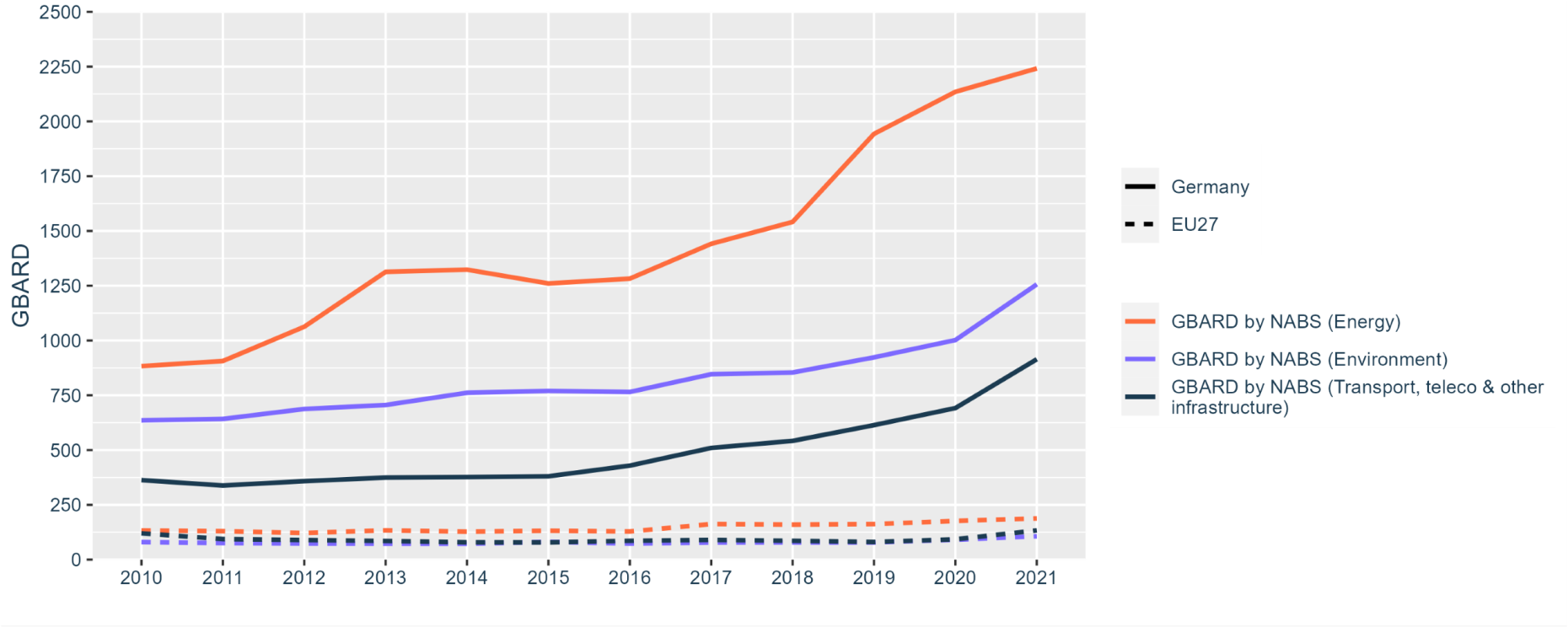

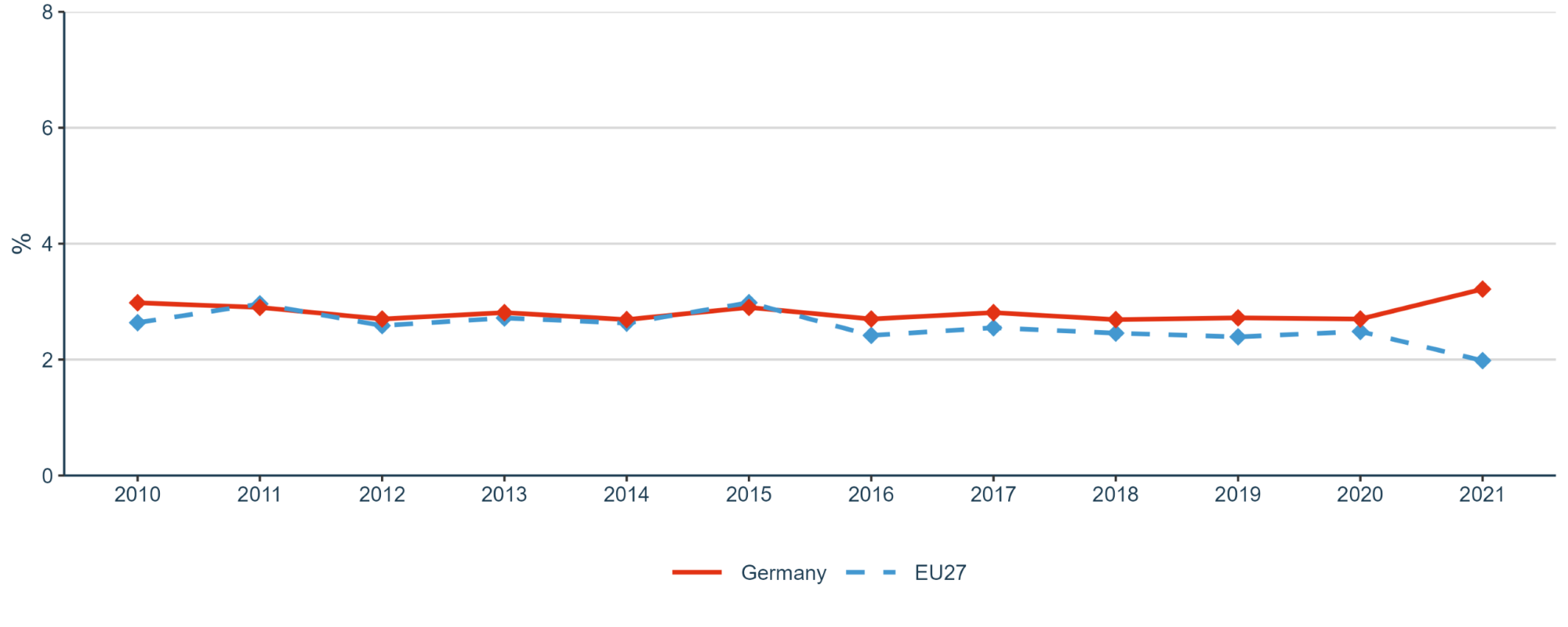
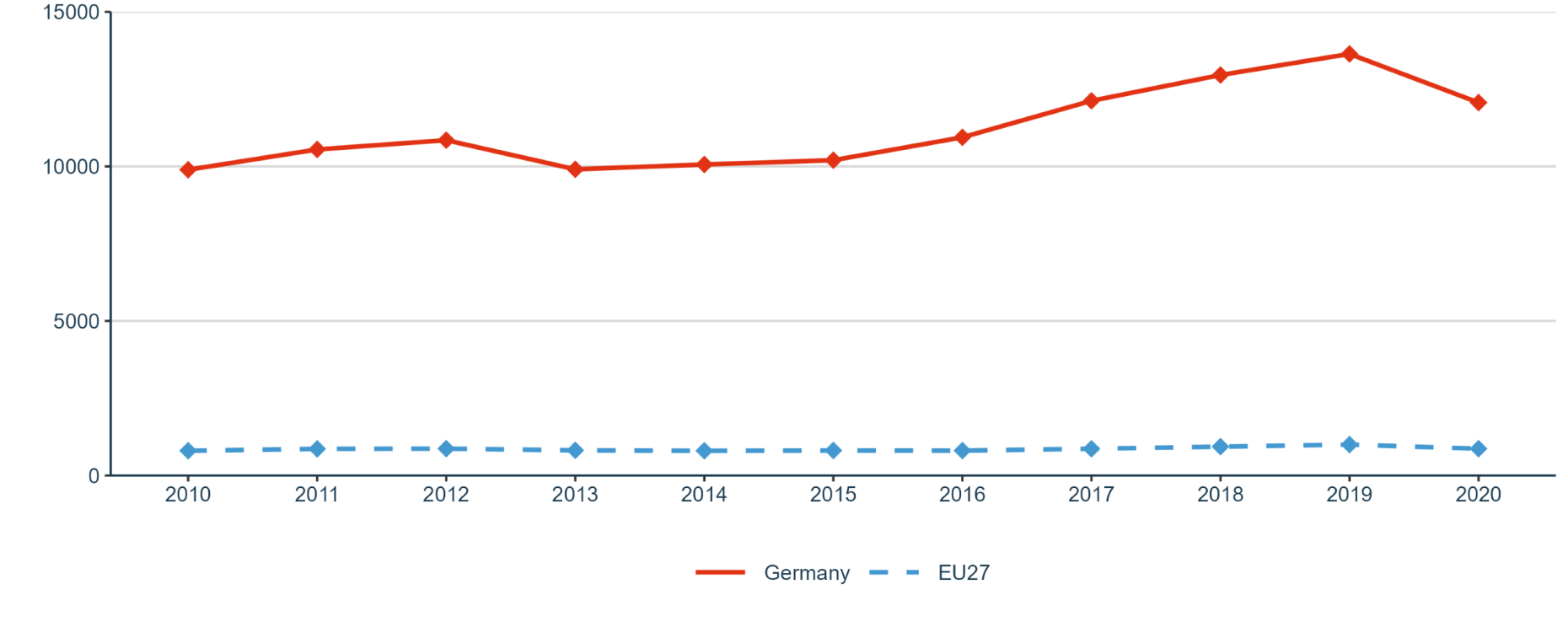

Sub-priority 2.2: Synergies with education and the European Skills Agenda
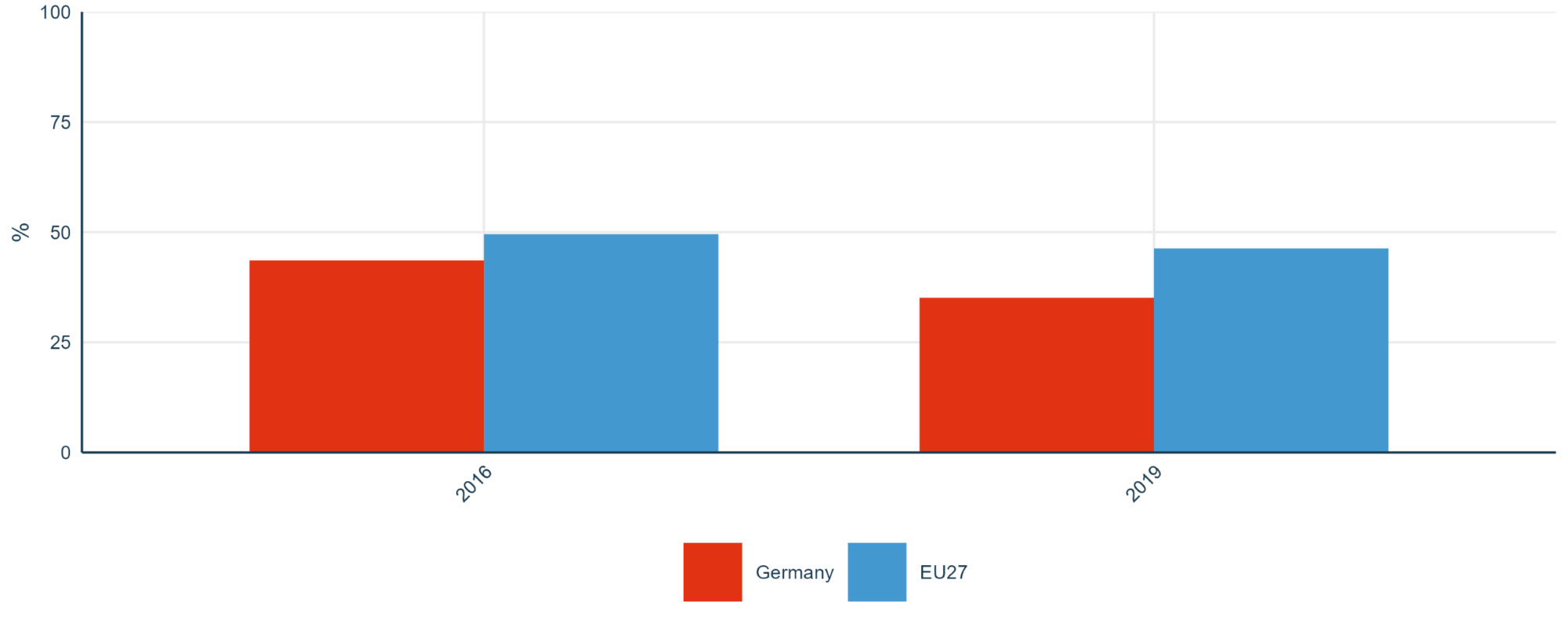
Sub-priority 2.3: Synergies with sectorial policies and industrial policy, in order to boost innovation ecosystems

Sub-priority 2.4: An active citizen and societal engagement in R&I in all its dimensions
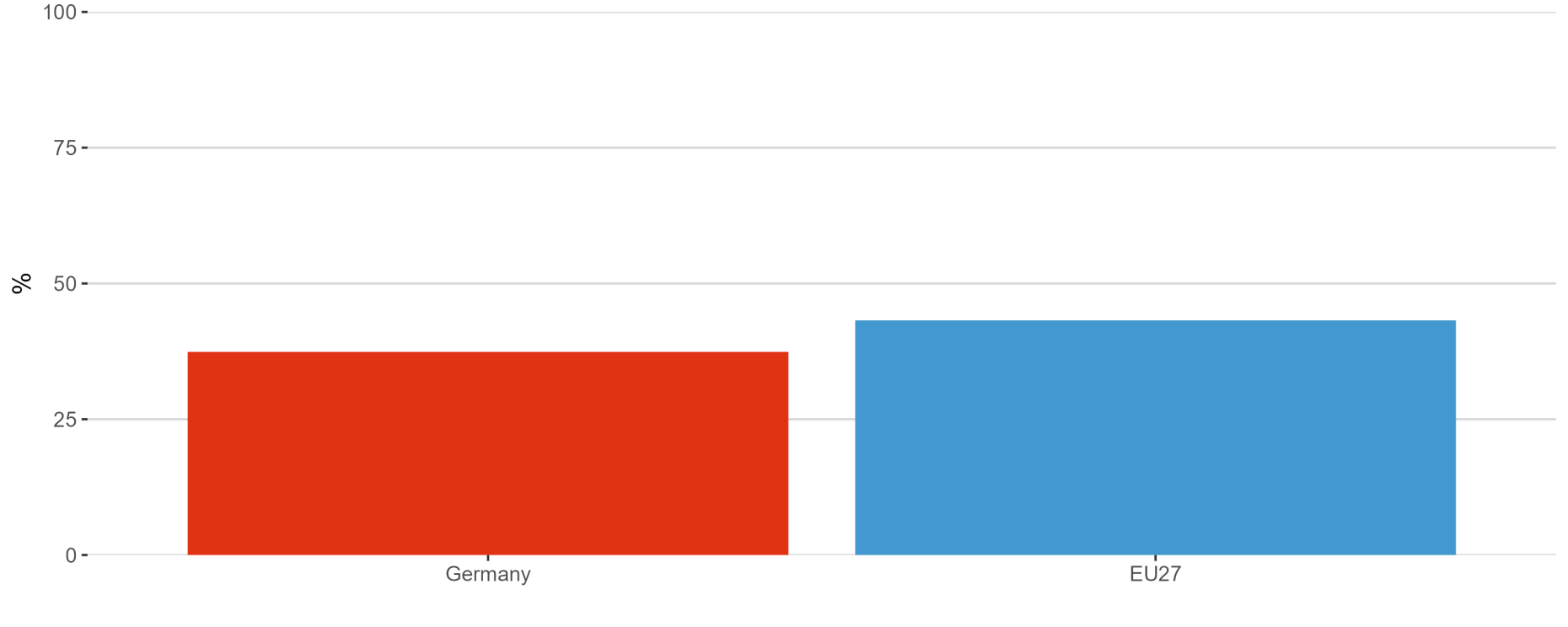
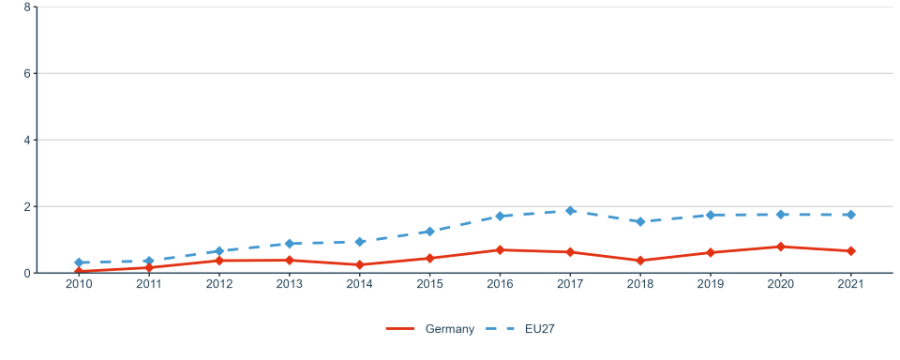
Priority 3: Amplifying access to research and innovation excellence across the Union
Sub-priority 3.1: More investments and reforms in countries and regions with lower R&I performance

Priority 4: Advancing concerted research and innovation investments and reforms
Sub-priority 4.1: Coordination of R&I investments
